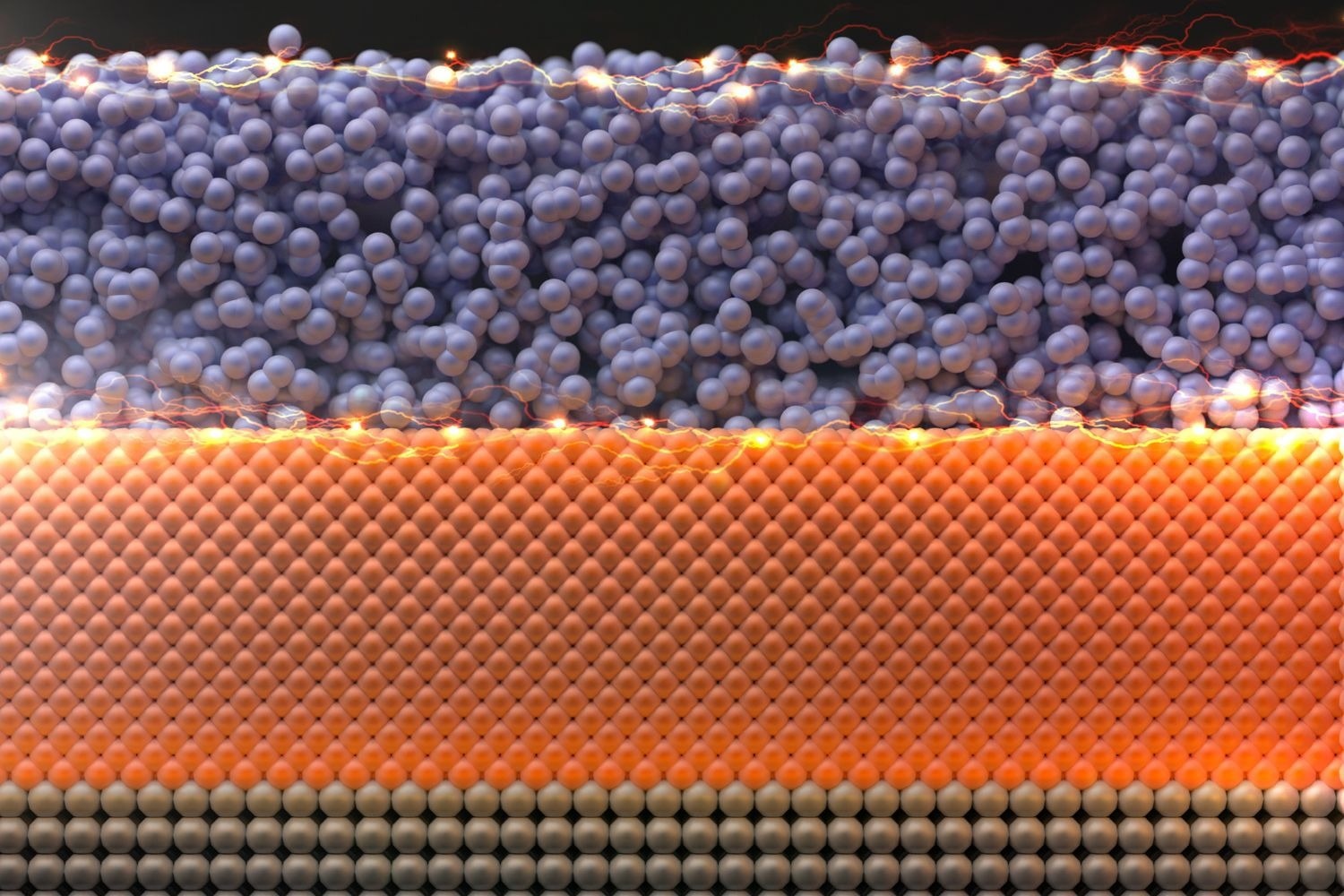Reviewed by Lexie CornerJan 9 2025
A recent study published in Science by researchers at Stanford University demonstrated that niobium phosphide films, only a few atoms thick, can conduct electricity more efficiently than copper.
 A film a few atoms thick of non-crystalline niobium phosphide conducts better through the surface to make the material, as a whole, a better conductor. Image Credit: Il-Kwon Oh / Asir Khan
A film a few atoms thick of non-crystalline niobium phosphide conducts better through the surface to make the material, as a whole, a better conductor. Image Credit: Il-Kwon Oh / Asir Khan
The ultra-thin metallic wires that carry electrical signals in computer chips present a significant limitation as chips become smaller and more complex. The size, efficiency, and performance of nanoscale electronics are constrained because conventional metal wires lose conductivity as they are scaled down.
Additionally, these films can be fabricated and deposited at temperatures compatible with modern chip manufacturing processes. This advancement could support the development of more powerful and energy-efficient electronics.
We are breaking a fundamental bottleneck of traditional materials like copper. Our niobium phosphide conductors show that it is possible to send faster, more efficient signals through ultrathin wires. This could improve the energy efficiency of future chips, and even small gains add up when many chips are used, such as in the massive data centers that store and process information today.
Asir Intisar Khan, Visiting Postdoctoral Scholar and Study First Author, Stanford University
Khan received his Doctorate from Stanford University.
A New Class of Conductors
Researchers classify niobium phosphide as a topological semimetal, a material where the entire bulk is electrically conductive, but its surfaces exhibit even higher conductivity than the interior.
As niobium phosphide films become thinner, the bulk contribution to conductivity decreases, while the surfaces maintain their conductivity. This shift allows the surface conduction to dominate, enhancing the material's overall conductivity. In contrast, conventional metals like copper lose their conductive properties when reduced below approximately 50 nm in thickness.
The researchers found that niobium phosphide outperformed copper as a conductor at thicknesses below 5 nm, even at room temperature. At this scale, copper wires experience significant energy losses due to heat dissipation and struggle to efficiently transmit high-speed electrical signals.
Really high-density electronics need very thin metal connections, and if those metals are not conducting well, they are losing a lot of power and energy. Better materials could help us spend less energy in small wires and more energy actually doing computation.
Eric Pop, Professor and Study Senior Author, Stanford University
Pop is the Pease-Ye Professor in the School of Engineering at Stanford University.
The most promising candidates to date have been materials with highly precise crystalline structures, which require extremely high temperatures for formation. Many researchers continue to explore alternatives for improved conductors in nanoscale electronics.
The niobium phosphide films developed by Khan and his team represent the first examples of non-crystalline materials that exhibit enhanced conductivity as their thickness decreases.
It has been thought that if we want to leverage these topological surfaces, we need nice single-crystalline films that are really hard to deposit. Now, we have another class of materials—these topological semimetals—that could potentially reduce energy usage in electronics.
Akash Ramdas, Doctoral Student and Study Co-Author, Stanford University
Niobium phosphide films can be made at lower temperatures because they do not have to be single crystals. The researchers deposited the films at 400 ℃, a low enough temperature to prevent harm or destruction of silicon computer chips already in use.
Yuri Suzuki, the Stanley G. Wojcicki Professor in the School of Humanities and Sciences, is a Professor of Applied Physics and a study co-author.
Suzuki said, “If you have to make perfect crystalline wires, that is not going to work for nanoelectronics. But if you can make them amorphous or slightly disordered and they still give you the properties you need, that opens the door to potential real-world applications.”
Enabling Future Nanoelectronics
Pop and his colleagues acknowledge that niobium phosphide films are unlikely to replace copper in all computer chip applications, as copper remains a better conductor for thicker wires and films.
However, niobium phosphide provides a foundation for exploring other topological semimetals as potential conductors and may be suitable for the thinnest interconnections. Researchers are already investigating similar materials to determine if they can surpass the performance of niobium phosphide.
“For this class of materials to be adopted in future electronics, we need them to be even better conductors. To that end, we are exploring alternative topological semimetals,” said Xiangjin Wu, Doctoral Student and Study Co-Author at Stanford University.
Pop’s group is also conducting further testing by forming their niobium phosphide films into thin wires. Their goal is to evaluate the material's reliability and effectiveness in practical applications.
Pop said, “We have taken some really cool physics and ported it into the applied electronics world. This kind of breakthrough in non-crystalline materials could help address power and energy challenges in both current and future electronics.”
Journal Reference:
Khan, A. I., et al. (2025) Surface conduction and reduced electrical resistivity in ultrathin noncrystalline NbP semimetal. Science. doi.org/10.1126/science.adq7096.